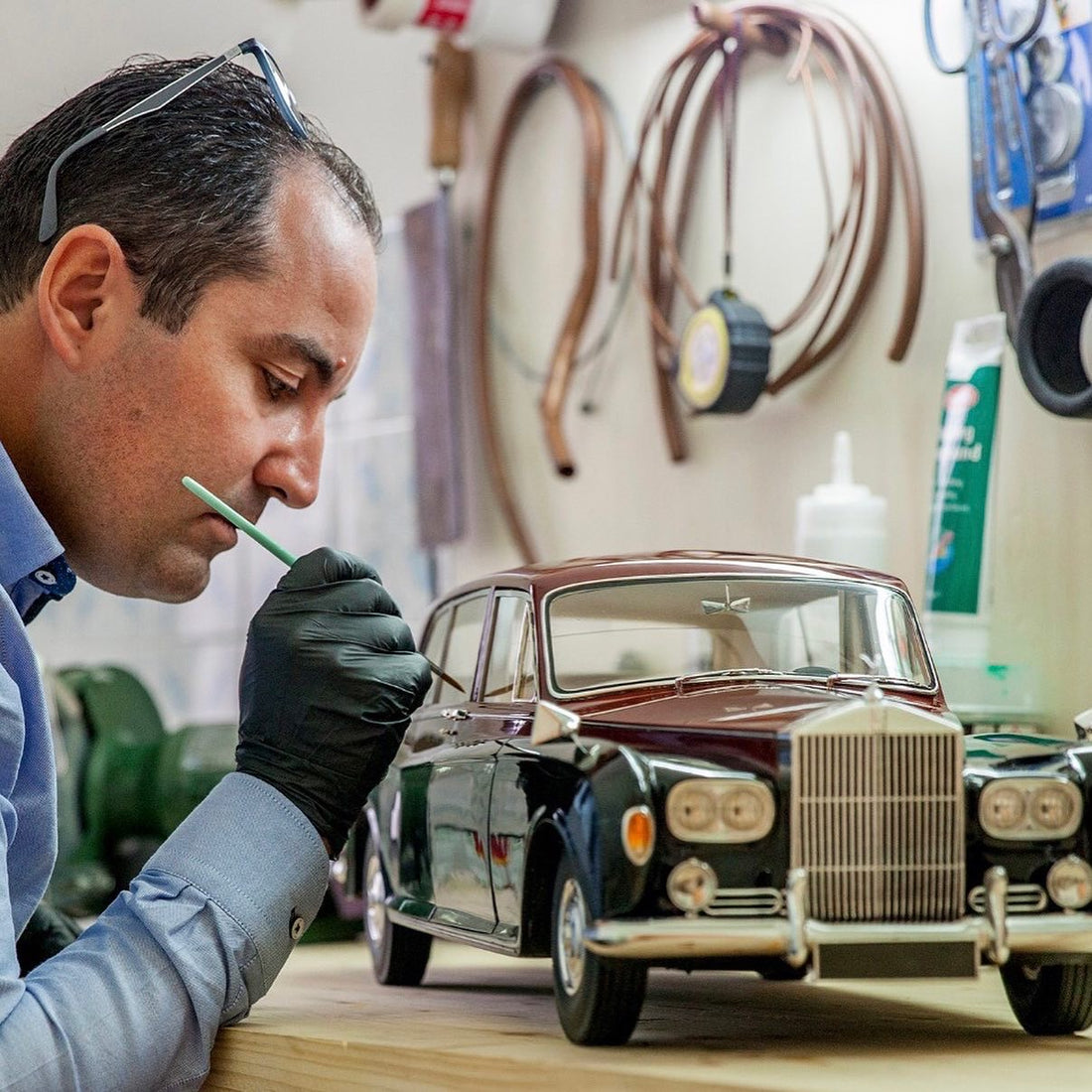

Maik Hahn - Aug 24 2024
The Art of Precision: Inside the World of Model Car Master Marco Laviola

In this exclusive interview, we sit down with Marco Laviola, a master craftsman known for his extraordinary model car creations. With a blend of meticulous detail, artistic passion, and a deep respect for automotive history, Marco takes us through his creative process, the challenges he faces, and the inspiration behind his work. From the crucial role of music in his studio to the invaluable contributions of his all-female team, Marco offers a fascinating glimpse into the world of model car making—a craft where precision meets emotion, and every piece tells a story.

Your model car creations are known for their meticulous detail and lifelike quality. Can you walk us through your creative process, from initial concept to the final product? What inspires you at each stage of this journey?
Marco: It all starts with the model that the customer decides to build. Often, these are cars they own, but sometimes they're vehicles they don’t own but wish to have a scale reproduction of—something to display in their villa’s living room, their office in a skyscraper in New York, or other special places. Once the model is chosen, I have all the internal and external photos of the car sent to me. As you might have seen in my videos, I keep these photos hanging in front of my work table. In fact, every workstation has photos displayed because I often work on multiple projects simultaneously.
I enjoy diving into the history of the model I’m about to build, and once I've done that, we begin construction.If it’s a model I’ve never built before, we start with the design and 3D printing in resin, which is done by a specialized company. When the pieces are ready, they arrive at my studio, and I start by cleaning them with sandpaper and putty. Then, I assemble all the pieces to see if everything fits together perfectly or if any adjustments are needed. Once everything checks out, the model is dismantled, and each individual part is painted. For example, I get immense pleasure working on the engines—I could spend forever perfecting the smallest details.When the pieces are ready, the final phases of assembly, finishing, polishing, and a thorough final check take place before shipping. Throughout this entire process, I’m thrilled to work with the knowledge of the car’s history and the people who worked on it—engineers, designers, mechanics, and so on. That’s why I put all my effort into making the scale model as realistic as possible, paying homage to all those who contributed to its original creation, now part of history.
Model car making is a unique blend of art and craftsmanship. How do you ensure that each model not only looks visually accurate but also captures the essence and spirit of the vehicle it represents?
Marco: The construction of scale models can be approached in two ways. If the requested model is one I've built before, I have molds of each individual piece carefully preserved. However, if it’s a model I’ve never created before, we start with the design and 3D printing in resin, which I outsource to a specialized company. Once I have the basic pieces, I add the intricate details, which might come from parts of modified kits or be built from scratch by me.
I use a wide variety of materials—anything from copper pipes and electrical wires to screens from pan splash guards, aluminum from cans, wood, and more. Each piece is artfully shaped and adapted to perfectly capture the spirit of the vehicle.
You’ve mentioned the importance of music in your daily video updates. How does music influence your mindset or creative flow when you’re working on a new model car? Does it play a role in the physical creation process as well?
Marco: Music is vital to me; it’s the only constant companion I have in my studio. Without it, I don’t think I could work. Sometimes I also listen to documentaries and stories about the world of motors. When I edit my daily videos and publish them on Instagram, I carefully choose the background music that best fits the video, ensuring it matches the cadence of the images and adds that extra emotional touch, even in a short 30 to 45-second clip.At the end of a model's construction, I accumulate many videos and stories throughout the process. The editing involves stitching together the footage, making cuts, and adapting the music tracks—calibrating the rhythm of the scenes to the music. The final post on my Instagram page showcases the key moments of the model’s construction, capturing the essence of the journey.


You’ve recently shared that you collaborate with three fantastic women who play a significant role in your work. Could you tell us more about this collaboration and how their unique perspectives and contributions have enhanced your creative process?
Marco: If everything runs smoothly and without a hitch, it’s largely thanks to the presence of three fantastic and talented women with whom I’ve been collaborating for a long time. Working with them has always been, and continues to be, a pleasure. There is a unique mutual respect between us.They say that women have an extra gear, and I can confirm it’s true—I see it every day in my work with them.
To break it down: I collaborate with Arianna from Lake Designe, an artist with a capital A. She specializes in restoring real motorcycles with airbrushing and hand-drawn "fillets," just like they did on vintage motorcycles and cars. She makes my life easier by handling the bodywork and specific designs for my models, meticulously applying original colors and friezes according to the codes and techniques of the time, but on a smaller scale.
Once the model is finished and ready for delivery, it needs to be immortalized with professional-quality photos. For this, I work with Esther Favilla, a photographer I’ve been collaborating with for several years. Esther is a top-level professional, and it was love at first sight when I saw her natural shots. I immediately fell in love with her photos and her technique, which beautifully highlights the elegance and detail of my models.
Lastly, there’s the shipping—a crucial and delicate part of the process. This is handled by Speedservice, an international shipping company owned by my dear friend and long-time collaborator, Mari (full name: Maria Antonietta). She’s always professionally prepared, incredibly smart and meticulous, overseeing every step of the model’s journey to ensure it arrives safely. She even puts up with my constant anxieties… ahaha!
Your model cars seem to reflect not just the physical appearance of vehicles but also evoke a certain emotion or atmosphere. How do you infuse this emotional depth into your models, and how important is this emotional connection for you as an artist?
Marco: For me, the emotion I feel and try to convey through my work is the most important aspect of the models. The construction of the models, the videos I create, and the music—all need to work together to satisfy me. If I don’t feel the right vibrations or emotions, I’ll adjust and sometimes even completely alter everything to achieve the right balance, which is then reflected in the final video, whether it’s a story or a post.
Creating model cars requires a great deal of patience and precision. What are some of the biggest challenges you face during the creation process, and how do you overcome them?
Marco: There are definitely moments of tension, especially during the crucial phases when you’re reassembling the model with its finished and painted pieces. Mistakes are not an option, but they do happen… ahaha! One particularly stressful moment is the “marriage” when the body is joined with the chassis, engine, and finished interiors. It’s a bit nerve-wracking because everything rarely falls into place on the first try. You have to carefully mill, widen, and file to ensure everything fits together perfectly.
In today’s digital age, many artists rely on 3D modeling software. However, you’ve stayed true to more traditional methods. What drives your passion for hands-on model making, and how do you see this craft evolving in the future?
Marco: As I mentioned earlier, I rely on an external company for the design and 3D printing, but the manual work—finishing, modeling, and attention to detail—is all done by me. I often work by hand, using various materials or resin molds to replicate the pieces. These phases always depend on the type of model being built and the level of detail required, such as whether the model should be fully closed, fully openable, or if the engine needs to be visible, and so on.
Your work has gained a significant following. How has the feedback from your audience influenced your approach to model car making? Are there any specific moments where fan input has led to a change in your creative process?
Marco: My follower count has been steadily growing, thanks largely to Instagram, which has given me visibility and clients from all over the world. There hasn’t been a specific moment where fan input drastically changed my creative process, but the growing audience certainly influences my work.Today, I’ve surpassed 100,000 followers, and for me, that’s a huge achievement and satisfaction. It means that what I do and the videos I share resonate with a broad audience—not just men, but also many women and young people. I hope the younger generation, in particular, catches the spirit and passion for this beautiful hobby, which can sometimes even turn into a real career. I’m grateful for their continued support and the motivation they give me every day.
Article credit: Maik Hahn - Photographs and Videos provided by Marco Laviola






